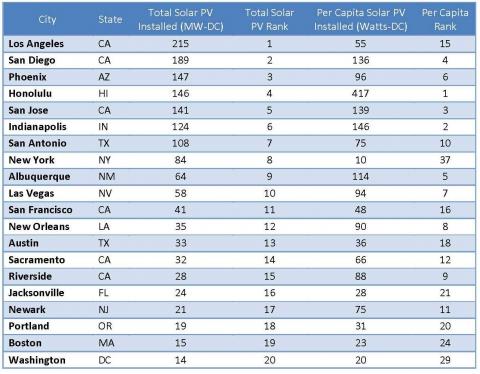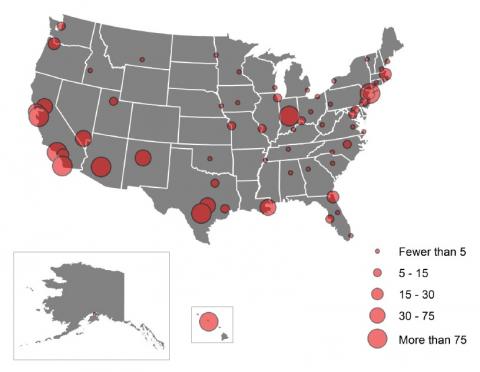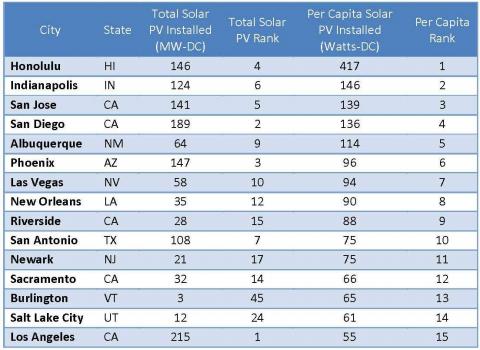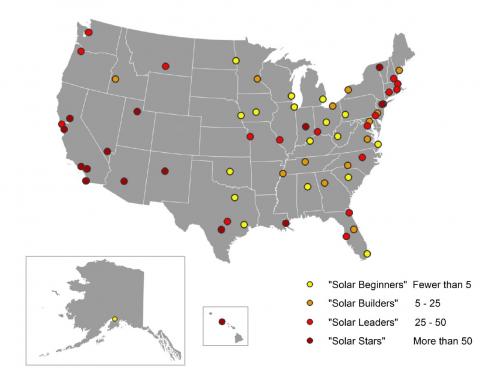Shining Cities 2016
How Smart Local Policies Are Expanding Solar Power in America
Solar power grew at a record-breaking pace in 2015. The United States now has more than 27,000 megawatts (MW) of cumulative solar electric capacity, enough to power more than 5.4 million American homes. Hundreds of thousands of Americans – especially in our cities – have invested in solar panels on their roofs or solar projects in their communities, and millions more are ready to join them.
Downloads
Solar power grew at a record-breaking pace in 2015. The United States now has more than 27,000 megawatts (MW) of cumulative solar electric capacity, enough to power more than 5.4 million American homes. Hundreds of thousands of Americans – especially in our cities – have invested in solar panels on their roofs or solar projects in their communities, and millions more are ready to join them.
America’s major cities have played a key role in the clean energy revolution and stand to reap tremendous benefits from solar energy. As population centers, they are major sources of electricity demand, and with millions of rooftops suitable for solar panels, they have the potential to be major sources of clean energy as well.
As of the end of 2015, 20 cities – representing just 0.1 percent of U.S. land area – accounted for 6 percent of U.S. solar photovoltaic (PV) capacity. The 64 cities in this report have installed over 1,700 MW of solar PV capacity – nearly as much solar power as the entire country had installed at the end of 2010. Los Angeles leads the nation in total installed solar PV capacity, followed by San Diego, Phoenix, Honolulu and San Jose.


The cities with the most solar PV installed per capita are the “Solar Stars” – cities with 50 or more watts of installed solar PV capacity per person. These cities have experienced dramatic growth in solar energy and are setting the pace nationally for solar energy development. Honolulu, Indianapolis, San Jose, San Diego and Albuquerque are the top five cities in the nation for installed solar PV capacity per person. Between 2014 and 2015, Burlington, Riverside, Las Vegas and Los Angeles joined the ranks of the Solar Stars.


Regional leaders for per capita solar capacity include Honolulu in the Pacific region, Albuquerque in the Mountain region, Indianapolis in the North Central region, New Orleans in the South Central region, Wilmington, Delaware, in the South Atlantic region and Newark, New Jersey, in the Northeast region.
America’s leading solar cities are those that have adopted strong pro-solar public policies or that are located within states that have done so.Among the most important steps cities have taken to advance solar energy are:
- Leading by example. Las Vegas has installed a total of 6.2 MW of solar electric capacity on 37 public buildings, community centers, fire stations and parks, including a 3.3 MW generating station at the city’s wastewater treatment plant. Tampa and Raleigh have also installed large PV systems on city facilities. The city of Atlanta recently unveiled a new plan to install about 2 MW of solar power on 28 city buildings. Cites that invest in solar power on public buildings not only save money on electricity, but they also demonstrate the value of solar energy to their residents.
- Power purchases by municipal utilities. The city of Austin is taking steps to add 450 MW of solar power capacity to its electric grid. Austin Energy, the city’s municipal electric utility, already supplies over 60 MW of solar energy to the local region. (As not all of these solar installations are within the Austin city limits, they do not appear within the tables above.)
- Expanding access through community solar policies. New York City ismaking it possible for multiple people to benefit from the same solar energy system. Residents who are unable to install solar panels on their own buildings will soon be able to purchase shares of solar power from other electric utility accounts.
In addition, cities with strong policies to compensate consumers for the solar energy they supply to the grid – such as net metering – are often leaders in solar development. Like rollover minutes on a cell phone bill, net metering gives renewable energy customers fair credit on their utility bills for the excess clean power they deliver to the grid. This simple billing arrangement is one of the most important state policies for clearing the way for customer investment in solar. Many of the leading solar cities and three out of four new “Solar Stars” have net metering policies that rank among the nation’s best.
Attacks by utilities and fossil fuel interests on net metering have the potential to remove some cities from solar leadership. For example, the controversial December 2015 decision by the Nevada Public Utility Commission to weaken net metering policies jeopardizes Las Vegas’ status as a solar energy leader.
U.S. cities have only begun to tap their solar energy potential. Cities such as Los Angeles, New York, Chicago and San Antonio have the technical potential to generate tens to hundreds of times more solar energy than they currently do, according to a recent National Renewable Energy Laboratory (NREL) analysis of rooftop solar potential. By maintaining strong pro-solar public policies, these and other cities can continue to lead America toward a future of 100 percent clean, renewable energy.
Strong public policies at every level of government can help the United States continue to harness clean solar energy and overcome legislative and regulatory barriers to distributed electricity generation. To achieve the nation’s full solar potential:
- Local governments should follow the lead of top solar cities by setting strong goals for solar energy adoption, implementing programs that promote the rapid expansion of solar energy, installing solar energy systems on government buildings, and urging state and federal officials and investor-owned utilities to facilitate that expansion.
- State governments should set ambitious goals for solar energy adoption and adopt policies to meet them. It is critical that states have strong policies, such as net metering, to fairly compensate owners of solar energy systems for the energy they supply to the grid. States can also enact strong renewable electricity standards with solar carve-outs, community solar legislation, tax credits for solar energy, and public benefits charges on electricity bills to raise funds for solar energy programs, as well as promote solar programs for low-income households. State governments should also use their role as the primary regulators of electric utilities to encourage utility investments in solar energy and implement rate structures that maximize the benefits of solar energy to consumers.
- The federal government should maintain federal tax credits for solar energy including provisions to enable nonprofit organizations, housing authorities and others who are not eligible for tax credits to benefit from those incentives. Investments should be increased for research, development and deployment programs designed to reduce the cost of solar energy and to speed the integration of renewable energy, energy storage and smart grid technologies into the grid.
